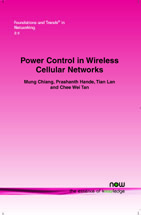Power Control in Wireless Cellular Networks
By Mung Chiang, Department of Electrical Engineering, Princeton University, USA, chiangm@princeton.edu | Prashanth Hande, Department of Electrical Engineering, Princeton University, USA | Tian Lan, Department of Electrical Engineering, Princeton University, USA | Chee Wei Tan, Department of Electrical Engineering, Princeton University, USA
Abstract
Transmit power in wireless cellular networks is a key degree of freedom in the management of interference, energy, and connectivity. Power control in both the uplink and downlink of a cellular network has been extensively studied, especially over the last 15 years, and some of the results have enabled the continuous evolution and significant impact of the digital cellular technology.
This survey provides a comprehensive discussion of the models, algorithms, analysis, and methodologies in this vast and growing literature. It starts with a taxonomy of the wide range of power control problem formulations, and progresses from the basic formulation to more sophisticated ones. When transmit power is the only set of optimization variables, algorithms for fixed SIR are presented first, before turning to their robust versions and joint SIR and power optimization. This is followed by opportunistic and non-cooperative power control. Then joint control of power together with beamforming pattern, base station assignment, spectrum allocation, and transmit schedule is surveyed one-by-one.
Throughout the survey, we highlight the use of mathematical language and tools in the study of power control, including optimization theory, control theory, game theory, and linear algebra. Practical implementations of some of the algorithms in operational networks are discussed in the concluding section. As illustrated by the open problems presented at the end of most chapters, in the area of power control in cellular networks, there are still many under-explored directions and unresolved issues that remain theoretically challenging and practically important.
Power Control in Wireless Cellular Networks
Power Control in Wireless Cellular Networks provides a comprehensive survey of the models, algorithms, analysis, and methodologies in this vast and growing research area. It starts with a taxonomy of the wide range of power control problem formulations, and progresses from the basic formulation to more sophisticated ones. When transmit power is the only set of optimisation variables, algorithms for fixed SIR are presented first, before turning to their robust versions and joint SIR and power optimization. This is followed by opportunistic and non-cooperative power control. Then joint control of power together with beamforming pattern, base station assignment, spectrum allocation, and transmit schedule are surveyed one by one. Power Control in Wireless Cellular Networks highlights the use of mathematical language and tools in the study of power control, including optimisation theory, control theory, game theory, and linear algebra. Practical implementations of some of the algorithms in operational networks are discussed in the concluding chapter.
